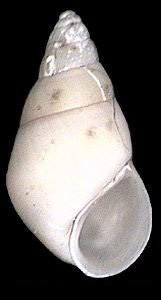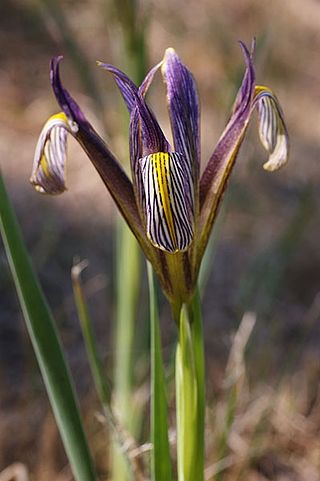
The International Union for Conservation of Nature (IUCN) Red List of Threatened Species, also known as the IUCN Red List or Red Data Book, founded in 1964, is an inventory of the global conservation status and extinction risk of biological species. A series of Regional Red Lists are produced by countries and organizations, which assess the risk of extinction to species within a political management unit.

Graecoanatolica macedonica is an extinct species of small freshwater snail, an aquatic gastropod mollusk in the family Hydrobiidae.

Hydrobia is a genus of very small brackish water snails with a gill and an operculum, aquatic gastropod mollusks in the family Hydrobiidae.
Iris pamphylica is a plant species in the genus Iris. It is the largest member of the subgenus Hermodactyloides, it is also in the section Reticulatae. It is a bulbous perennial from Antalya Province in Turkey, Asia. It has long narrow leaves, shorter stem holding a bi-coloured flower in shades of purple, blue or purple-brown, with a yellow, purple-spotted section on a petal.

Iris masia, commonly known as the barbed iris, is a species in the genus Iris, it is also in the subgenus Limniris and in the series Syriacae. It is a rhizomatous perennial from the Middle East and Asian Turkey. It has long grass-like leaves, unbranched stems with single flowers in late spring, in shades from purple to violet blue.
Graecoanatolica anatolica is a species of freshwater snail, an aquatic gastropod mollusk in the family Hydrobiidae. The species is endemic to the Düden Waterfalls of Turkey.
Graecoanatolica brevis is a species of freshwater snail, an aquatic gastropod mollusk in the family Hydrobiidae. The species is endemic to Pinar Gözü Springs in Turkey.
Graecoanatolica conica is a species of freshwater snail, an aquatic gastropod mollusk in the family Hydrobiidae. The species is endemic to a spring between the Turkish villages of Çardak and Dazkırı.
Graecoanatolica dinarica is a species of freshwater snail, an aquatic gastropod mollusc in the family Hydrobiidae. The species is endemic to Turkey, and is an endangered species due to pollution and habitat loss.
Graecoanatolica kocapinarica is a species of freshwater snail, an aquatic gastropod mollusk in the family Hydrobiidae. The species is endemic to a spring outside Aşağı Gökdere Village in Turkey.
Graecoanatolica lacustristurca is a species of freshwater snail, an aquatic gastropod mollusk in the family Hydrobiidae. The species is endemic to Lake Beyşehir and Lake Eğirdir in Turkey.
Graecoanatolica vegorriticola is a hydrobiid gastropod endemic to littoral habitats in Lake Vegorritis and Lake Patron. It is listed as Critically Endangered by the IUCN, mainly due to habitat loss as a result of the eutrophication of Lake Patron, and the effects of pollution upon the remaining suitable habitat near Lake Vegoritida. When described, it was reported that the species was found in great abundance on the margins of Lake Vegorritis, but in 2006 only the remnants of the original population were found.
Lacerta pamphylica is a species of lizard in the family Lacertidae. It is endemic to Turkey.




